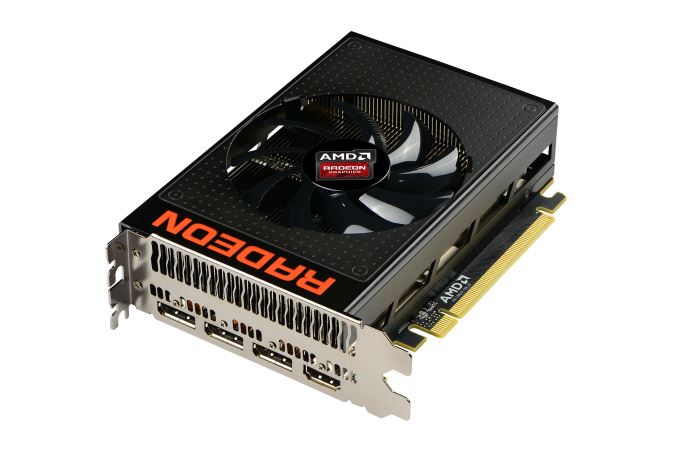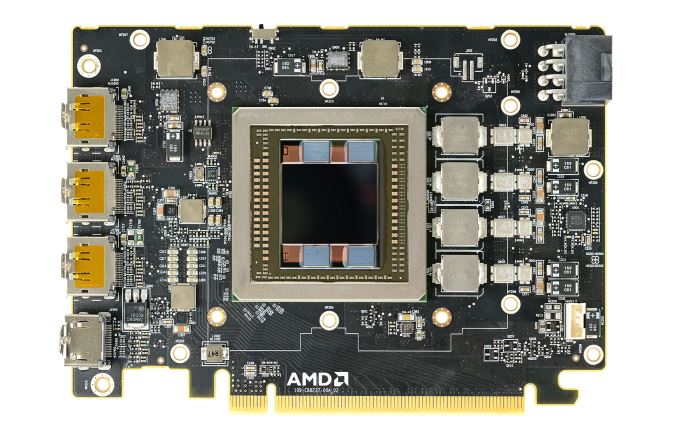The AMD Radeon R9 Nano Review: The Power of Size
by Ryan Smith on September 10, 2015 8:00 AM ESTFinal Words
Of all of the Fiji-based cards we’ve looked at so far, I feel like the Radeon R9 Nano is the most interesting of them. It’s not the fastest card or the cheapest card, but I like that AMD is trying unconventional things. A product like the R9 Nano will never be a high volume product, but it’s the kind of outside the box thinking AMD needs to do in order to better differentiate themselves from NVIDIA and to escape their increasingly damaging reputation as the value alternative underdog.
To that end there’s a lot to like about the R9 Nano, though it admittedly defies standard categorization at times. By all practical metrics this is a luxury card in the same vein as NVIDIA’s GTX Titan series, but at the same time it’s not a card built for chart-topping performance. Rather it’s a card built to push the envelope on power and space efficiency. This makes AMD’s job to sell the card to the public both harder and easier, though not always for obvious reasons.
Starting with the highlights then, let’s talk about the size. As far as Mini-ITX cards go the R9 Nano is a card without an equal. It is the fastest Mini-ITX card on the market and comfortably so, thanks to the fact that all other cards in this space are based on lower performing parts such as the GeForce GTX 970 and Radeon R9 380. Producing a small card is a solid, practical application of the Fiji package and the space savings of HBM, allowing AMD to produce a card just 6 inches (152mm) long. If you need the fastest thing that fits into 170mm or less – and you don’t mind paying top dollar for it – then the R9 Nano has earned its place right there.
Meanwhile when it comes to energy efficiency, the R9 Nano also marks a new high point for AMD. To cut right to the chase, AMD has struggled on the subject of energy efficiency for some time now, particularly since NVIDIA launched their Maxwell 1 and Maxwell 2 architectures last year. The release of the R9 Nano represents a significant improvement for AMD, showing us what an energy efficient implementation of Fiji is capable of.
Relative to the other Fiji cards – the Radeon R9 Fury series – AMD has been able to significantly cut their power consumption in exchange for a limited performance regression. At 2560x1440 – what I expect will be the gaming sweet spot for the R9 Nano – the card delivers 90% of the R9 Fury X’s performance and 96% of the R9 Fury’s performance. Though a tangible decrease in performance, it comes with 35% and 20% decrease in power consumption respectively, allowing AMD to offer better performance-per-watt than any other Radeon product to date.
Now there is a catch here, and that these efficiency improvements come from chip binning and a careful crafting of the product specifications, and not from an architectural improvement. On the whole Fiji still needs to draw quite a bit of power to achieve its peak performance and R9 Nano doesn’t change this. Instead with R9 Nano AMD makes a deliberate and smart trade-off to back off on GPU clockspeeds to save significant amounts of power. The last 100MHz of any chip is going to be the most expensive from a power standpoint, and as we’ve seen this is clearly the case for Fiji as well.
Otherwise on a broader competitive basis, while AMD is enjoying an improvement in energy efficiency they still must contend with NVIDIA, and here is where things get murky. Relative to the rest of their lineup the R9 Nano’s energy efficiency is fantastic. However relative to the energy efficiency of NVIDIA’s lineup, AMD’s gains mostly serve to close the gap that already existed. While admittedly only painting the broadest of strokes here, R9 Nano demonstrates slightly better performance than GTX 980 –around 5% at 2560x1440 – for a similar increase in power consumption. Which is to say that AMD has closed the gap, but they don’t have any real lead.
As a result the answer to the question “is there a market for energy efficient cards within the desktop space?” is going to hinge on price, and that puts AMD in a rough spot given the R9 Nano’s status as a luxury card. Clearly there’s a market for such cards – NVIDIA has spent the last year doing just that – but price is clearly a factor as well. Luxury products typically offer something that no other product offers, and while AMD’s energy efficiency has improved here, they aren’t offering a level of efficiency NVIDIA wasn’t already offering. And that as a result makes AMD’s task all the harder; they can’t pitch energy efficiency as a luxury element if NVIDIA already offers it.
In the end then the R9 Nano is a mixed bag for potential buyers. Its $650 price tag is without a doubt steep compared to the R9 Fury X and GTX 980 Ti, but in its niche of Mini-ITX cards it’s the card to beat, and that will give AMD the room they need to charge that price. On the other hand as great as R9 Nano’s power consumption and energy efficiency are, unless you also need the small size it doesn’t do enough to set itself apart from cheaper products like the GTX 980.
Finally, turning our eyes towards the future, there is one final Fiji product launch on AMD’s 2015 roadmap, and that is the unnamed dual Fiji card. By launching the R9 Nano first, AMD has primed the pump to potentially take their dual-GPU card in one of two different directions. They could essentially combine a pair of R9 Fury Xs and go for a maximum power, maximum performance card similar to the Radeon R9 295X2. On the other hand if they were to combine a pair of R9 Nanos they could produce a slightly slower but much more power efficient card. Both configurations have their virtues and weaknesses – energy efficiency versus absolute performance – so it should be interesting to see which of these two routes AMD takes later this year.












284 Comments
View All Comments
LoneWolf15 - Thursday, September 10, 2015 - link
And as someone who has been a long time TR reader and has met him multiple times, I am in complete disagreement with you. His testing is some of the most detailed and accurate that I know.I have little faith in your ability to determine someone's subliminal gifts.
Kutark - Thursday, September 10, 2015 - link
Unfortunately a great many people are incapable of projecting their own biases onto someone else. Tomshardware and Anandtech have been accused of being pro one team or the other for years.I remember an article i read a few years back, i wish i could remember the guys name, but he was chief editor for one of the macintosh magazines, and he was talking about how he got so fed up with users because if he said literally anything negative about the product he would get his email inbox blown up with accusations of being a MS nutswinger, and fellating Bill Gates, and various other things. He gave an example of one of the ipods which he gave like a 90%+ review, and the ONLY negative things he said was that the casing was shiny, so it took fingerprints really well and was hard to keep looking clean, and that he wished the battery life was a little bit longer. He said he got the most vitriolic and ridiculous emails he'd ever seen.
The problem is people want confirmation that they made the right choice, and if they don't get that, then rather than admit that they made a mistake, they would rather attack the reviewer as being a fanboy or something equally hideous.
medi03 - Friday, September 11, 2015 - link
In Fermi times Anand found it "appropriate" to compare cherry picked OCed nVidia card vs stock AMD."Subtle bias" my ass.
Ryan Smith - Friday, September 11, 2015 - link
It's something we've apologized for, repeatedly. It was a poor idea and we readily admit as much.http://www.anandtech.com/show/3988/the-use-of-evga...
mapesdhs - Monday, September 14, 2015 - link
I never saw the need to apologise; the price of the FTW meant it was the far better choice to buy back then (I bought two for SLI).fuicharles - Friday, September 11, 2015 - link
I used to go to The Tech Reports to read the Top News contents everyday. Their Top News was always updated and shared lots of recent development.However, recently something fishy, Tech Reports doesn't share any news on the recent Gamesworks and Asyn Compute tragedy in their sites.
And try to pin point the Pump Whine problem even after AMD has already come up new revision of Fury Card which solve the problems.
I don't want to believe Scott Wasson is biased either, but isn't that as a journalist you should share the bad/good for both camp to let the readers judge themselves
milli - Friday, September 11, 2015 - link
'most detailed and accurate' ≠ unbiasedDon't worry that you didn't notice the hidden bias. It took me a while to realize it. After reading TR for a couple years, around 2006 I started noticing the bias. It's not what he says that's biased but what he doesn't say/report that makes him biased. He's smart.
Well he's getting better at hiding his bias these last years. In the previous decade he would often pit OC'd nVidia cards with stock AMD cards in his 'reviews'.
Just like many knew that Anand was biased towards Apple with his ridiculously positive reviews until the final proof came when he went to actually work for them.
slickr - Saturday, September 12, 2015 - link
He has been shilling for Nvidia for good several years now, everything Nvidia does = great, amazing, unique, always winning in some ultra specific aspect even if realistically the card is garbage, when he talks about AMD = power consumption is 10W or 20W more than Nvidia, Nvidia clear winner, price and performance don't matter, only those 10W difference matters.No way for AMD to win, I would have not sent review copies to a whole more websites, there are at least 4-5 of top of my head that are Nvidia shill town and they not even doing it subtly.
althaz - Monday, September 14, 2015 - link
nVidia have had a lead in performance for half a decade or more now - it's not tech reviewers fault that AMD are using more power to deliver worse performance at similar prices.chrnochime - Saturday, September 12, 2015 - link
And we're suppose to have faith in YOUR view of SW? LOL